The classic maximum point blank method makes sighting-in more complicated than necessary.
The maximum point blank range technique requires that one sight in to be 4″ above the point of aim at the peak of the trajectory. This means that folks must compute the trajectory an an intermediate distance when using typical public shooting range distances of 100 or 200 yards. We recommend simplifying the process by adopting a sight-in height of 1.5″ above point of aim at 100 yards.
Here’s why:
The method does not add much to the effective point blank range compared to using the more simple 1.5 inches above point of aim at 100 yards.
The 1.5″ high at 100 yards gets one close to the maximum point blank range while keeping a very simple zero. Second, today’s world offers the hunter relatively inexpensive access to a wide variety of laser range-finders. This hardware allows precise measurement out to distances further out than one should responsibly attempt a shot at medium game. For most of us with smartphones, that precise range can almost instantly give the holdover needed to get an accurate, if not precise, shot into the vital zone. With this neat equipment, why would one bother with arcane techniques like ‘maximum point blank range’ (MPBR) to get at most an extra 25 or so yards where the aim point is at the center of the vital zone?
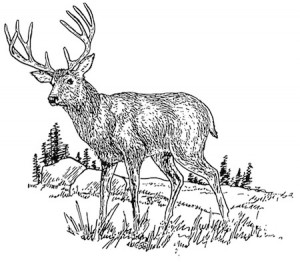
Figure 1. Deer weights range from about 90 lb (40 kg) for does in the southern US to averages as high as 350 lb (160 kg) or more for bucks in northern states. The corresponding vital zones are as little as 7″ for the smaller deer to about 12″ for the largest. Line drawing courtesy of Pearson Scott Foresman (http://openclipart.org/people/papapishu/Deer_2_.svg)
While many of us dream of taking shots ‘way out there’ like we saw in Quigley Down Under, most game is taken at surprisingly short ranges with the vast majority of medium game being harvested within a few hundred yards of the shooter. As the distance separating the hunter from the quarry decreases, small movements and other random events increase the chances of the animal being spooked and running before a proper shot can be taken. The hunter does not have much time to accurately measure the range, consult drop and drift tables, smartphones, and so on when the range is within a hundred yards or so.
The ‘maximum point blank range’ (MPBR) technique is often cited by gun writers as a method for minimizing the need to accurately estimate the range, consult drop and drift charts, etc. within the ranges where game is easily spooked. In effect, the technique allows one to choose a single aim point for the close range shots and not worry about the more challenging techniques until the target is more than a few hundred yards out. While the MPBR as defined by most authors seems simple and effective, deeper inspection of real world issues suggests a minor modification to assure effective and ethical use of the technique.
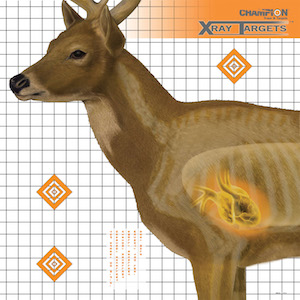
Figure 2. This excellent X-RayTM deer target shows us where the top of the heart is and a glance at the 1” hash marks tells us that a 10” vital zone is possibly optimistic for this 190 lb deer. The author is indebted to Champion Targets (www.championtarget.com) for giving permission to use this life-size target with vital organs displayed along with dimension lines.
The ‘maximum point blank range for hunting’ is defined as the distance over which a bullet stays within a defined distance above or below the line of sight. While some authors correctly note that the right combination of vital zone size and rifle can yield a MPBR of around 400 yards, the practical range is much less. Shot dispersion, wind, and the effect of slope on trajectory all combine to make the chances of a solid hit in the vital zone rapidly diminish as the distance goes out past 200 – 250 yards. Further, the MPBR zero requires that the bullet is three, four, five, or more inches above the line of sight at intermediate ranges. This behavior adds stress and unneeded attention when practicing at intermediate ranges in the field.
Alternatively, sighting the rifle so the bullet is 1.5” high at 100 yards keeps the bullet within the vital zone of deer for a substantial majority of popular hunting cartridges over this distance. This form of zero is both easier to establish for most shooters and allows a center hold for the small targets frequently used for unknown range practice within about 200 yards of the shooter.
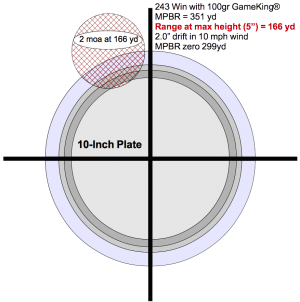
Figure 3. At least half of the bullets will miss the vital zone at peak trajectory. Modest winds will cause more misses. Cross hatched circle shows where a .243 Win sighted for MPR shot at 166 yd showing showing where most bullets will hit with 2 MOA accuracy will hit on 10″ Paper Plate in 10 mph wind. The MPBR technique seeks to allow the hunter to use a single aim point at all ranges from the muzzle out to the maximum point blank range. As we see here, prudence must be used in defining the diameter of the circle to allow for wind drift and dispersion.
The MPBR can mislead a hunter by giving the impression that a vital zone hit is guaranteed at that and shorter distances. In blindly following the notion the hunter can unknowingly take shots that are otherwise unethical. We can loosely define a hunter’s maximum practicable range as the longest range an ethical shot can be taken. An ethical shot is one that the shooter is reasonably certain that the animal will be taken cleanly and with minimal tracking needed. Shots that wound, but otherwise allow an animal to escape the immediate area are unethical when they result from careless application of shooting skills. The notion of ‘ethical shot’ reduces the true range one should consider taking a shot by simply aiming where he thinks the top of the heart is.
We normally use the radius of the target animal’s vital zone to specify the maximum allowable distance from the line of sight when applying the technique. We see from Figure 1 that the vital zone is a comparatively small region extending from just below the bottom of the animal’s heart to the top part of the lungs with a width that is about the same as the height. The vital zone is centered at about the top of the heart. This region is filled with blood vessels. Rupturing enough of these vessels, particularly the arteries, results in rapid loss of blood pressure in the brain and fainting and anchoring the animal for recovery by the hunter.
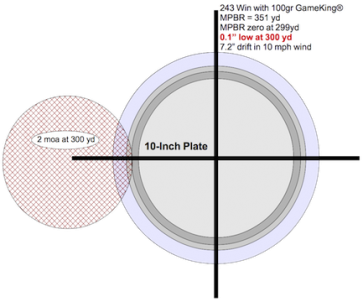
Figure 4. The maximum Point Blank range technique fails under even modest winds. The illustration is based on a 10mph cross wind but it is easy to see that most shots would miss the plate in even a 5mph wind.
Why this area rather than a head, neck, spine, or shoulder shot? The head moves frequently and unpredictably, so a shot aimed at this target frequently misses even though a hit assures instant knock down. The neck shot is generally effective only when the spine, jugular vein or carotid artery are severed. These are small regions and hard to visualize. The same is true of the spine along the animal’s back. These regions are difficult targets even though some hunters choose them over the vital zone.
With a vital zone diameter of about ten inches, the radius for deer-sized game weighing about 150 pounds becomes about five inches. Within the point blank range, the idea is that all the shooter has to do is to hold the crosshairs at the top of the animal’s heart and there is an excellent chance of cleanly taking the quarry. This is because hits slightly above the heart will disrupt the lungs, while hits in and below the heart will interrupt blood flow to other vital organs.
Accuracy of the rifle, shooter, and ammunition combination serve to limit the range at which and ethical shot should be taken. Other factors also impact the true point blank range. For example, Figure 2 and Figure 3 both show us that drift from moderate winds, particularly with small caliber bullets can easily blow a bullet’s impact out of the vital zone. This more subtle factor also limits the range where no sight picture corrections are needed.
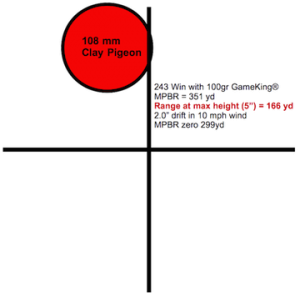
Figure 5. One has to use offset aiming to hit the practice target (clay pigeon) even though it would likely have been a good hit on the hunted animal. The need to move the crosshairs completely off the target illustrates one of the challenges one faces when attempting to practice at intermediate ranges with the MPBR.
Hunting accuracy is a lot different than bench rest accuracy. Many of us can routinely get 1 to 1.5 inch groups from the bench with our favorite deer-buster. When we go into the field and put adrenaline and excitement on top of a pounding heart, heavy breathing and lest than perfect rifle support, our true accuracy goes south real fast! We can reasonably assume that most shooters who can get 1.5 inch groups at the bench will see at least a doubling of dispersion in the field. That doubling results in three-shot groups going to the limit of our nominal vital zone at 300 yards even if the group is perfectly centered. We show a more optimistic dispersion of 2 moa in Figures 1 and 2. Even this tighter than likely field-attainable group size can result in misses.
With the 300 yard representative group size pushing six to ten inches, we see that more than half our shots will miss the nominal 10-inch circle at 300 yards because of wind effects, bullet drop and dispersion for most rifles. We need to pull the maximum practicable range back a bit so that the combined drop and dispersion keeps most shots within the circle. The resultant allowable point-blank drop is therefore less than five inches. While, one can do a precise trajectory and hit probably calculation to get a precise number, we can now readily see why Randy Wakeman’s paper recommends a 3-inch radius circle for planning purposes for most medium game. This means that most of us should shoot at ranges of less than about 300 yards to be more confident in attaining hits in the vital zone. Planning to take game at greater distances should wait until we have done the additional practice and obtained the necessary field experience to have high confidence of solid hits at greater ranges.
This table compares maximum point-blank ranges for the 3” radius circle with wind drift at 200 yards and the slightly smaller range one gets if the rifle is sighted in so the bullets are 1.5 inches high at 100 yards.
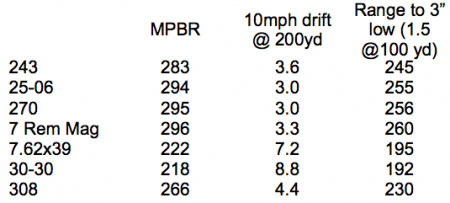
Figure 6. We see that the standard definition maximum point blank range adds only a few tens of yards to what might be attainable with the 1.5″ high at 100 yards sight-in. Further, the added range is far enough out that the hunter can and should be using a laser range finder to get the correct range. Eyeballing the range can result in errors of 20% to 30% off of the actual range.
This first observation is that the bullet has an excellent chance of drifting off to the side of the circle within 200 yards when there is a noticeable wind from the left or right. A closer look reveals that there is not a lot of difference in the maximum point-blank range for these cartridges. Indeed these maximum point-blank ranges are only about sixty yards more than we see with even the 100+ year old 30-30 or the slightly newer 7.62 x 39 Russian cartridges.
The last column in the chart above is the range where the bullet would drop three inches below the line of sight when sighted in 1.5 inches high at 100 yards. We can see that we lose maybe 15 per-cent with the more conservative sight-in. With a maximum trajectory height of three inches, we are obliged to hold at the bottom of the clay pigeon at intermediate ranges with a MPBR sight-in for the 6” diameter vital zone. The easier to verify 1.5” high zero generally keeps the bullet within the extent of the pigeon over intermediate ranges, making practice easier to understand.

Figure 7. The 1.5 inch high at 100 yard sight-in allows the shooter to hold at the center of typical plinking targets (e.g., clay pigeon) to significant ranges while still keeping a good max range for vital zone hits while aiming at the top of the heart.
A little work with a ballistics calculator shows that the holdover and left-right corrections needed to get routine first-round hits out to 300 yards is not much different with this zero than when going with the maximum point-blank range method. In both cases, the change in aim point stays within the body of most medium game even out to 300 yards. We see that the added effort to use the standard maximum point-blank range buys only a few tens of yards of “point and shoot” comfort and that practice is made easier and more productive with the more conventional sight-in condition.
| Navigation Buttons: | ShootersNotes | The Fouling Shot | The Hunting Zero |
|---|

 sending...
sending...